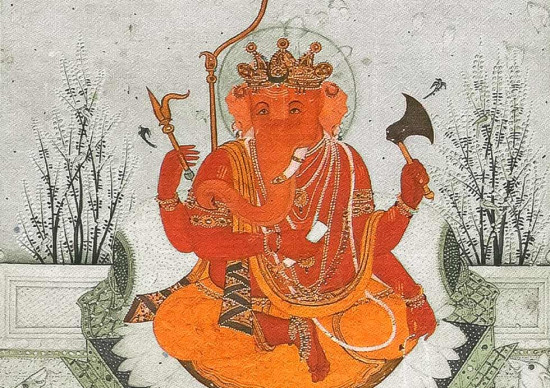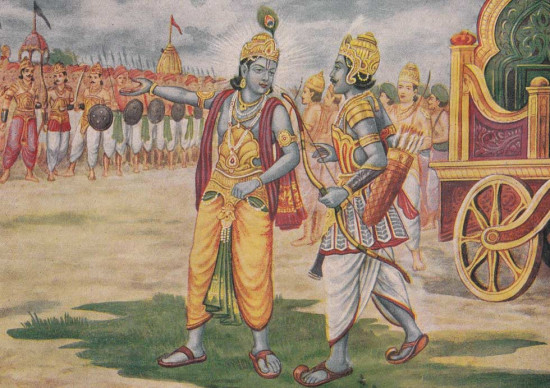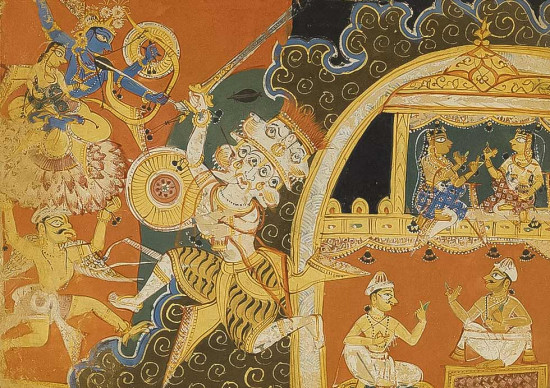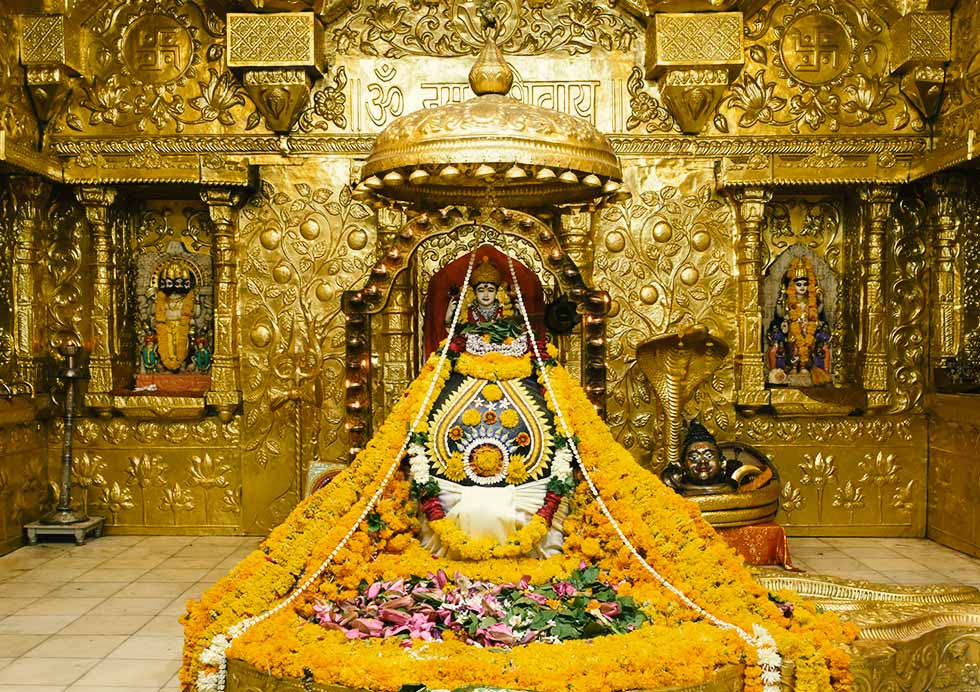
Somnath Temple is one of the most popular pilgrimage destinations in India. It is located in Prabhas Patan, near Veraval in the Saurashtra region of Gujarat. Every year, a large number of Hindus visit this place. They worship Lord Shiva here. And, connect themselves to the world of spirituality.
Somnath Jyotirling Temple has a magnificent history and is a great place in Hindu mythology. It has always been a place for Hindus, right from ancient times. Let’s get more knowledge about its history, significance, modern architecture, and famous legends associated with it in detail.
Somnath Jyotirling Temple has a magnificent history and is a great place in Hindu mythology. It has always been a place for Hindus, right from ancient times. Let’s get more knowledge about its history, significance, modern architecture, and famous legends associated with it in detail.
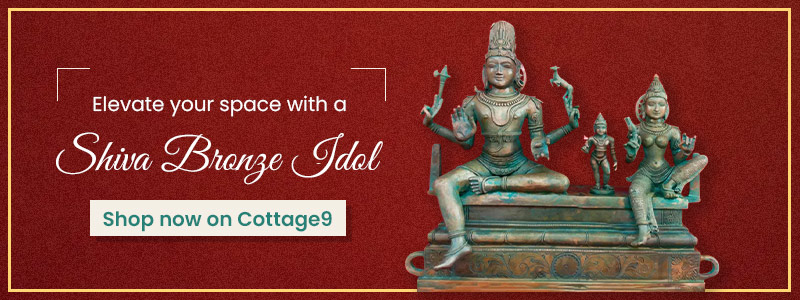
Somnath Temple History
Somnath Jyotirling Temple has a long history. It is several thousand years old. Its name, “Somnath,” means- "Protector of the Moon God. As per the Hindu mythology, Somnath Mahadev Mandir was first built by the Moon God, Soma.
As the story goes, Lord Shiva himself appeared here. He helped Lord Chandra (Moon) to discard Daksha’s curse. Daksha Prajapati is considered the son of Lord Brahma. His 27 daughters married Lord Chandra. But, he was devoted only to Rohini. He ignored others. This angered Daksha Prajapati.
He cursed Lord Chandra to fade his luster and beauty. So, Lord Chandra came to Prabhas Patan. He did Tapasya (penance) to get rid of his father-in-law’s curse. Lord Shiva became impressed with it. He appeared in front of Lord Chandra & blessed him to regain his lost beauty & magic. This made Lord Chandra happy.
He established a Shivalinga (of gold) at this place. Therefore, people worship Lord Shiva here as Somnath. And, the temple was named “Somnath Temple”. In different yugas (ages), this temple was reconstructed. Ravana reconstructed it in silver, Lord Krishna in sandalwood & Bhimdev in stone. Ancient Hindu books (such as the Skanda Purana and the Rigveda) mention the Somnath Jyotirlinga Temple.
You can get a carefully crafted Stone Shiva Lingam from Cottage9. It is perfect for home or temple placement. It will create a religious atmosphere at the place. Order today & get it in a few days at your specified address. Feel free to explore other statues and get them as required.
As the story goes, Lord Shiva himself appeared here. He helped Lord Chandra (Moon) to discard Daksha’s curse. Daksha Prajapati is considered the son of Lord Brahma. His 27 daughters married Lord Chandra. But, he was devoted only to Rohini. He ignored others. This angered Daksha Prajapati.
He cursed Lord Chandra to fade his luster and beauty. So, Lord Chandra came to Prabhas Patan. He did Tapasya (penance) to get rid of his father-in-law’s curse. Lord Shiva became impressed with it. He appeared in front of Lord Chandra & blessed him to regain his lost beauty & magic. This made Lord Chandra happy.
He established a Shivalinga (of gold) at this place. Therefore, people worship Lord Shiva here as Somnath. And, the temple was named “Somnath Temple”. In different yugas (ages), this temple was reconstructed. Ravana reconstructed it in silver, Lord Krishna in sandalwood & Bhimdev in stone. Ancient Hindu books (such as the Skanda Purana and the Rigveda) mention the Somnath Jyotirlinga Temple.
You can get a carefully crafted Stone Shiva Lingam from Cottage9. It is perfect for home or temple placement. It will create a religious atmosphere at the place. Order today & get it in a few days at your specified address. Feel free to explore other statues and get them as required.
The Significance of Somnath Temple
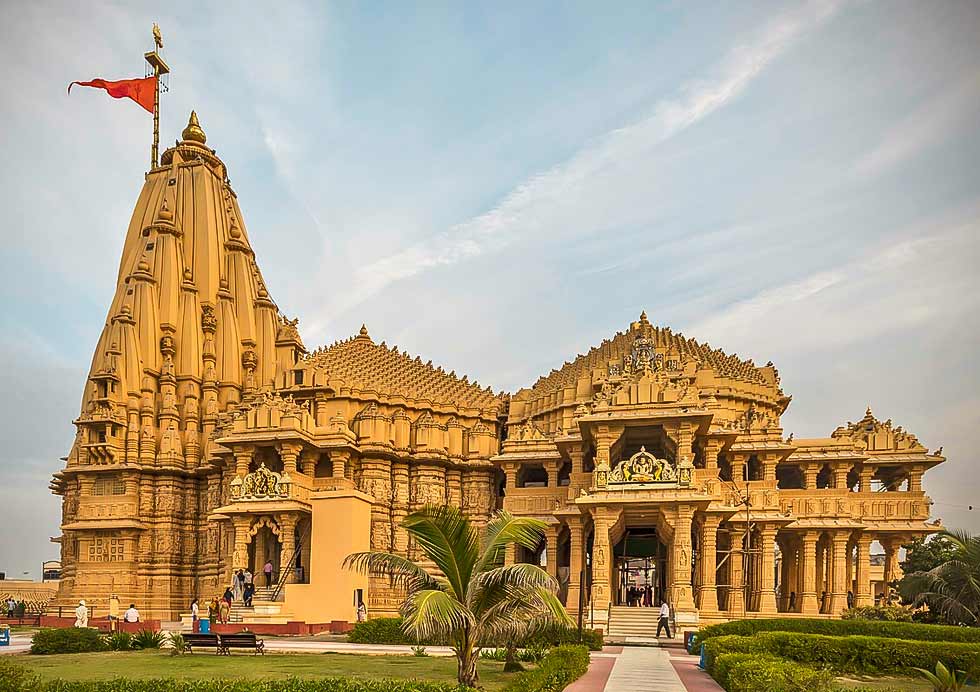
The Somnath Mahadev Mandir has great historical and religious significance. It is considered the first of the twelve sacred Jyotirlingas of Lord Shiva. It symbolizes divine power, steady faith, and spiritual renewal. Millions of Hindus visit this temple every year to worship Lord Shiva. It is believed that doing so can help rid them of their sins, attain peace, and get moksha (liberation). It displays never-ending faith in God. By visiting here, people honor centuries of devotion.
Modern Somnath Temple Architecture
The modern architecture of Somnath Mandir is amazing. It is a perfect fusion of contemporary art and ancient wisdom. It follows the Chalukya style (also known as the Solanki style of architecture). This style was quite popular in western India between the 10th and 13th centuries.
So, the present-day Somnath Temple has-
So, the present-day Somnath Temple has-
- Shikhar (main tower)- at 155 feet.
- Garbhagriha (Sanctum Sanctorum)- It has Somnath Jyotirlinga, a symbol of Lord Shiva's eternal presence.
- Kalash (pinnacle)- It is covered in gold and weighs around 10 tons.
- Mandapam (Assembly Hall)- It is a large hall for devotees. It has carefully carved pillars and traditional motifs from Vedic scriptures.
Remember, the entire Mandir structure is built with red sandstone.
Famous Statues Associated with Somnath Mandir
Always remember, the Somnath Mandir is more than just a pilgrimage site. It has impressive mythological legends related to divine beings, epic events, and cosmic symbolism. The temple is associated with the Moon God (Chandra Dev) and Lord Shiva.
As per the Mahabharata, the Triveni Sangam (confluence of three rivers) is near Somnath Mandir. It is the place where Lord Krishna left his mortal body. When the Mahabharata war ended, Lord Krishna went to Dwarka.
One day, he was resting under a tree at Bhalka Tirth near Somnath. A hunter named Jara mistook Krishna’s foot for a deer and hit him. It wounded Lord Krisha badly. It is widely believed that Lord Krishna left the earth from this place. It ended the Dwapara Yuga and started the Kali Yuga.
As per Hindu mythology, Lord Shiva promised to protect Somnath forever. So, the Jyotirlinga is believed to have a column of divine light with no beginning or end. The spiritual presence of the Jyotirlinga remains unaffected over time. It reflects the fact that Shiva protects the temple’s soul at all times.
It is also believed that dying or performing penance at Somnath let people have freedom from the cycle of birth and death. Markandeya Rishi meditated here and got Moksha.
As per the Mahabharata, the Triveni Sangam (confluence of three rivers) is near Somnath Mandir. It is the place where Lord Krishna left his mortal body. When the Mahabharata war ended, Lord Krishna went to Dwarka.
One day, he was resting under a tree at Bhalka Tirth near Somnath. A hunter named Jara mistook Krishna’s foot for a deer and hit him. It wounded Lord Krisha badly. It is widely believed that Lord Krishna left the earth from this place. It ended the Dwapara Yuga and started the Kali Yuga.
As per Hindu mythology, Lord Shiva promised to protect Somnath forever. So, the Jyotirlinga is believed to have a column of divine light with no beginning or end. The spiritual presence of the Jyotirlinga remains unaffected over time. It reflects the fact that Shiva protects the temple’s soul at all times.
It is also believed that dying or performing penance at Somnath let people have freedom from the cycle of birth and death. Markandeya Rishi meditated here and got Moksha.
Somnath Temple Aarti Timings
The Somnath Temple has daily aarti ceremonies. It is performed 3 times a day. A good number of devotees participate in religious practices here.
Daily Aarti Timings
Prabhat Aarti (Morning Aarti)- 7:00 AM
Madhyan Aarti (Noon Aarti)- 12:00 PM
Sandhya Aarti(Evening Aarti)- 7:00 PM
Somnath Mandir Darshan Timings
Remember, the temple remains open from 6:00 AM to 10:00 PM. So, you can come here and see the divine presence of Lord Somnath throughout the day.
Daily Rituals
Apart from the aartis, the Somnath Temple has a light and sound show everyday 8:00 PM to 9:00 PM (not during the monsoon season). It lets people learn about the temple's legacy and its importance in Hindu religion.
Somnath Temple Festivals
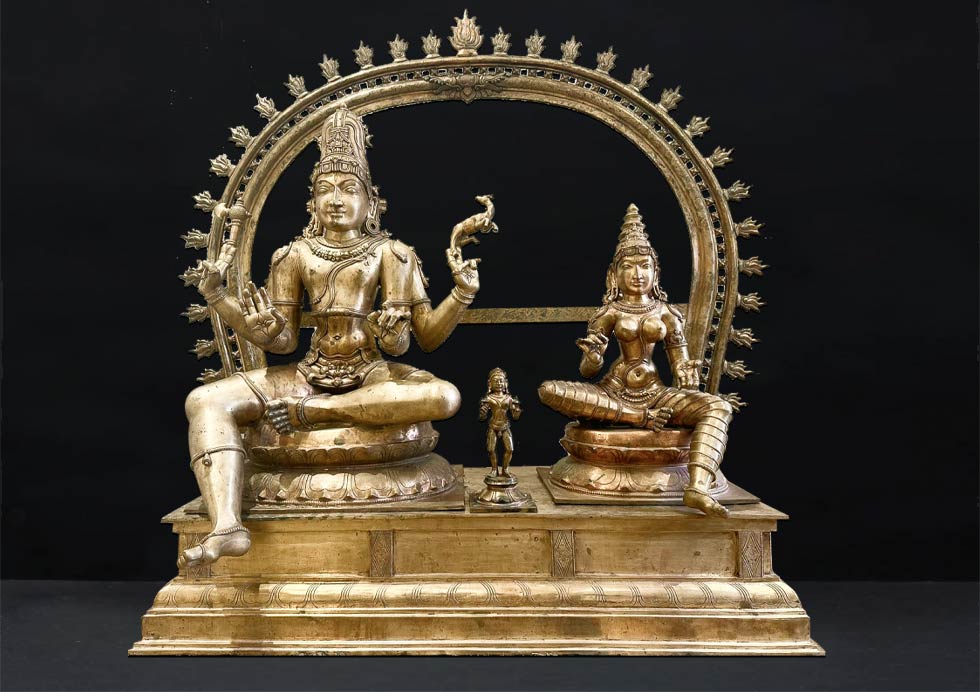
Many festivals take place in the Somnath temple. Here are some of them-
Maha Shivratri
During this festival, devotees celebrate the divine marriage of Lord Shiva and Goddess Parvati. It takes place on the 14th night of the dark fortnight (Krishna Paksha) during Phalguna (February–March). People fast and observe Jagaran (night-long vigils). They perform Rudrabhishekam (ritual bathing of the Shiva lingam) with milk, honey, and ghee. Moreover, Bhajans are also organized. Devotees gather at Somnath for darshan and prayers, and exchange religious greetings.
Kartik Purnima
It takes place in the month of Kartik (October–November). People celebrate the birthday of Lord Shiva here. They take a holy dip at Triveni Sangam. Here, three rivers (Hiran, Kapila, and Saraswati) meet. Moreover, they illuminate thousands of diyas (oil lamps) in the temple and its surroundings. Special Aartis and cultural events are also organized.
Kartik Purnima
It takes place in the month of Kartik (October–November). People celebrate the birthday of Lord Shiva here. They take a holy dip at Triveni Sangam. Here, three rivers (Hiran, Kapila, and Saraswati) meet. Moreover, they illuminate thousands of diyas (oil lamps) in the temple and its surroundings. Special Aartis and cultural events are also organized.
Shravan Month Celebrations
Devotees worship Lord Shiva during the entire month of Shravan (July–August). They perform Abhishekams and special worship. Kanwariyas (devotees) take holy water from rivers and offer it to the Jyotirlinga. It is considered a pious act by Hindus and a way to connect to the almighty God.
Somvati Amavasya
It is a new moon day that falls on a Monday (Somvar). Hindus consider it extremely pious for worshiping the Lord Shiva. They take holy baths in Triveni Sangam. Moreover, they chant Shiva Sahasranama (1000 names of Shiva) and worship him.
Diwali and Annakut
A day after Diwali, devotees offer hundreds of food items to God. They illuminate the temple with lamps and lights and witness the grand Annakut (Govardhan Pooja) Aarti. Prasadam (blessed food) is distributed among devotees.
Navratri and Dussehra
During the nine nights of Navratri (September–October), a large number of people visit Shri Somnath Temple. They organize Garba and Dandiya dances near its complex and sing devotional songs. Special worships are also organized to worship the goddess Durga & Lord Shiva.
Navratri and Dussehra
During the nine nights of Navratri (September–October), a large number of people visit Shri Somnath Temple. They organize Garba and Dandiya dances near its complex and sing devotional songs. Special worships are also organized to worship the goddess Durga & Lord Shiva.
Conclusion
Somnath Jyotirlinga Temple has a rich history, legacy, significance, and relevance. It is a center of attraction for all Hindus. They visit here throughout the year in large numbers to connect themselves to God, remove their sins, and attain Moksha. It displays divine power and religious resilience.
Take your time to see the beautifully designed paintings and statues on Cottage9. We have a rich product catalog for everyone. Our paintings and statues are ideal for placement in homes, temples, or any religious spots. You can also give them to the temple trust, hermits, loved ones, etc. We are always ready to process your order.
Take your time to see the beautifully designed paintings and statues on Cottage9. We have a rich product catalog for everyone. Our paintings and statues are ideal for placement in homes, temples, or any religious spots. You can also give them to the temple trust, hermits, loved ones, etc. We are always ready to process your order.

